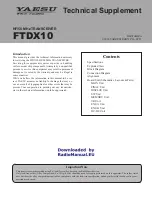
144
10
MEMORY OPERATION
1
2
3
4
5
6
7
8
9
10
11
12
13
14
15
16
17
18
19
20
21
You can call up a memo pad by pushing [MP-R] one or
more times while in either the VFO or Memory mode.
• The memo pad data is called up, starting from the most
recently written.
When you call up a memo pad, the previously dis-
played data is automatically stored in a temporary pad.
The temporary pad can be recalled by pushing [MP-R]
one or more times.
• You may think there are 6 memo pads because 6 different
frequencies (5 are in memo pads and 1 is in the temporary
pad) are called up by [MP-R].
If you change the data called up from a memo pad,
the stored temporary pad data is replaced with the
changed data.
■
Memo pad function
The transceiver has a Memo pad function to store
the displayed data for easy writing and recalling. The
memo pads are separate from the Memory channels.
The default number of memo pads is 5. However, you
can increase the number to 10 in the “Memopad Num-
bers” item of the Set mode, if desired. (p. 164)
Memo pads are convenient when you want to memo-
rize the displayed data temporarily, such as when you
find a DX station in a pile-up, or when a desired station
is busy for a long time and you want to temporarily
search for other stations.
Use the transceiver’s memo pads instead of relying on
hastily scribbled notes that are easily misplaced.
D
Writing the displayed data into memo pads
You can store the displayed data by pushing [MP-W].
When you store the 6th data into memo pads, the old-
est stored entry is automatically erased, to make room
for the new data.
A G C
D U P
C O M P
T B W
S C P
M 1
In this example, 21.347 MHz (USB) will be
erased when 21.280 MHz (LSB) is written.
Memo pads
Erased
Newest
Oldest
A G C
D U P
C O M P
T B W
S C P
M 1
Newest
Oldest
NOTE:
Each memo pad must have its own unique
set of data; memo pads having identical data cannot
be written.
D
Calling up the memo pads
Memo pads
Push
Push
Push
















































